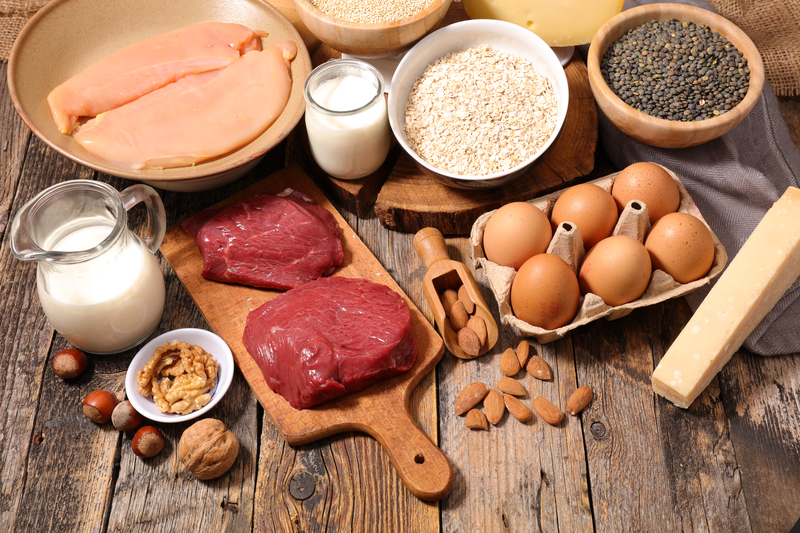The 67 Best Sources of Protein For Weight Loss

If you’ve been reading the BioTrust blog for any length of time, you know about the big benefits of eating more protein. For starters, dietary protein provides the amino acids that are essential for:
- Growth and repair of tissues, including lean muscle mass and skin
- Maintaining healthy bodily functions
- Making proteins that our bodies require, like enzymes, hormones, neurotransmitters, and more
Beyond those primary functions, the best sources of protein may offer several other distinct advantages, such as:
- Increased metabolic rate
- Increased calorie burning
- Feeling fuller for longer (i.e., increased satiety)
- Improved diet quality
- Reduced appetite and calorie intake
- Protecting and even building calorie-burning lean mass
- Providing 2 to 10 times the thermic effect of feeding over carbs or fats
And fortunately, no matter what type of diet you prefer to follow—whether you’re vegan, Paleo, carnivore, or anything in between—you can find healthy, higher protein options.
So, what are the best sources of protein for your diet?
The Best Sources of Protein

Meat
(per 3-ounce cooked serving unless otherwise noted)
- Bacon: 10 g (per oz)
- Canned Chicken: 21 g
- Canadian Bacon: 15 g
- Chicken Breast: 24 g
- Chorizo: 21 g
- Corned Beef: 24 g
- Lamb: 23 g
- Ground Beef: 18 g
- Lean Jerky: 10 to 15 g per oz
- Pepperoni: 18 g
- Pork Chops: 26 g
- Roast Beef: 18 g
- Steak (top or bottom round): 23 g
- Turkey Breast: 24 g

Fish/Seafood
(per 3-oz serving)
- Anchovies: 24 g
- Canned light tuna: 22 g
- Crab: 18 g
- Halibut: 23 g
- Lobster: 16 g
- Sardines: 21 g
- Salmon: 22 g
- Scallops: 14 g
- Shrimp: 18 g
- Tuna: 22 g

Eggs and Dairy
- Cheddar Cheese: 7 g (per oz)
- Cottage Cheese: 27 g (per cup)
- Egg: 6 g (per egg)
- Greek Yogurt: 24 g (per cup)
- Milk: 8 g (per cup)
- Mozzarella Cheese: 7 g (per oz)
- Regular Plain Yogurt: 11 g (per cup)
- Swiss Cheese: 8 g (per oz)

Plant-Based Options
(per ½-cup serving)
- Adzuki Beans: 9 g
- Black Beans: 8 g
- Black-eyed Peas: 7 g
- Broccoli: 1 g
- Brussels sprouts: 2 g
- Chickpeas: 7 g
- Edamame: 8 g
- Sprouted Grain Bread: 4 g (per slice)
- Fava Beans: 7 g
- Hummus: 10 g
- Kamut: 6 g
- Lentils: 9 g
- Lima Beans: 6 g
- Navy Beans: 10 g
- Oats (dry): 6 g
- Peas: 4 g
- Pinto Beans: 11 g
- Quinoa: 4 g
- Red Kidney Beans: 8 g
- Spinach (cooked): 3 g
- Wheat Berries: 6 g
Nuts & Seeds
(per 1-oz serving)
- Almonds: 6 g
- Cashews: 4 g
- Chia seeds: 5 g
- Flaxseeds: 6 g
- Mixed nuts: 3 g
- Peanuts: 7 g
- Pistachios: 6 g
- Pumpkin seeds: 9 g
- Sunflower seeds: 6 g
- Walnuts: 4
Want one of the best sources of protein that is also super convenient? Try a high-quality protein powder. While we may be a bit biased, there’s a good reason. We work hard to provide our customers with the highest quality, best-tasting protein powders on the planet, including:
- BioTrust Low Carb: 24 g
- Platinum 1 Grass-Fed Whey Protein: 25 g
- Ageless Multi-Collagen: 10 g
- Harvest Plant Protein (vegan): 20 g
How Much Protein Do You Need?
While we strongly believe in personalizing your diet to your preferences and activity levels, a good general guideline (that’s scientifically supported) for most folks who exercise regularly is right around .73 grams per pound of body weight per day.
Just to give you a general idea before you dive into your calculator app, for a 140-pound person, that’s about 102 grams; for a 180-pound person, that’s 131 grams; and for a 200-pound person, that’s 146 grams.
The Best Sources of Protein: A Recap
Protein is an important macronutrient that literally provides the building blocks for a healthy body. Its benefits can’t be overstated. With so many choices for the best sources of protein, it’s easy to add it to every meal (which we highly recommend you do)—no matter what your preferred diet.






